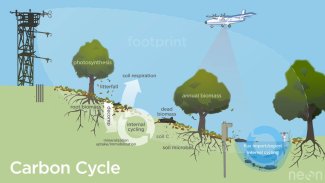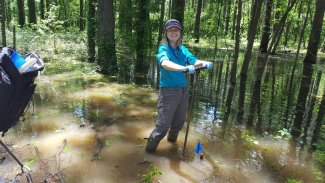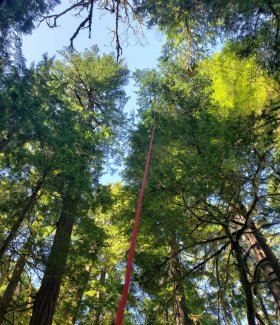Biogeochemistry

Biogeochemistry is the study of how essential elements that support life—such as carbon (C), nitrogen (N), and phosphorus (P)—move, or cycle, through different components of the ecosystem. Elements are continually cycling between soil, water, living organisms (including plants, animals, and microbes), and the atmosphere. Studying biogeochemical cycles provides insights into ecological processes and the way ecosystems respond to changes in climate, land use, or other human activities or disruptive natural events such as floods or forest fires.
Biogeochemical measurements quantify the storage and movement of carbon and nutrients through the biological, hydrological, and geological components of the ecosystem. Biogeochemical cycles play a central role in regulating Earth's climate and the health of terrestrial and aquatic ecosystems. Carbon and nutrients naturally move through the ecosystem via the water cycle and activities of organisms (e.g., respiration, consumption, excretion, and decomposition).
Human activities also impact element fluxes. Energy production and industrial activities remove stored carbon from the Earth's surface and add it to the atmosphere as carbon dioxide (CO2). Modern agriculture relies on fertilizers that artificially add nitrogen, phosphorus, and other nutrients to the soil; these nutrients can migrate through the ecosystem and make their way into streams, lakes, and oceans through runoff. Observing continental-scale variation in biogeochemical cycles as well as the direct and indirect effects of human activities is a central goal of NEON.

Diagram of the carbon cycle at a NEON site
Sampling Design and Methods
In order to understand the cycling of key elements and compounds, NEON measures major biogeochemical inputs, outputs, stocks, fluxes, and processes. Resulting data quantify the chemistry of precipitation, plants, soil, sediments, surface water, and groundwater.
The key categories of measurements made by NEON include:
- Inputs: atmospheric deposition, chemical properties of groundwater, carbon uptake
- Outputs: stream nutrient concentrations, evapotranspiration, and respiration, dissolved gasses in surface water
- Stocks: carbon and nutrient pools in plant biomass and soils, chemical properties of aquatic sediment collected from depositional zones, chemical properties of algae and macrophytes
- Fluxes: net ecosystem carbon exchange, soil respiration, evapotranspiration and plant litter (i.e., litterfall)
- Processes: microbial activity, soil net N transformation rates, stream reaeration rates
Carbon and nutrient concentrations and fluxes within an ecosystem are crucial components of ecological science. Researchers can combine multiple NEON measurements and data streams to quantify these components and understand more complex ecological processes. For example, biomass and carbon exchange estimations for the continent require models that incorporate remotely sensed vegetation data, eddy covariance measurements, plant community observations, and plant nutrient analyses.
The NEON Observational Sampling system includes the collection of biogeochemical data from:
- Soils and sediments
- Terrestrial plants, aquatic plants, and microalgae
- Surface and groundwater
- Atmospheric deposition
The OS system is focused on discrete measurements of biogeochemical pools and fluxes, but the Instrument System (IS) also collects info on biogeochemistry via continuous sensor measurements (and link to relevant IS pages – eddy covariance, soil sensors, aquatic sensors).
Soils and Sediments

Field technician soil sampling in a forest floodplain at the DELA field site in Alaska
Soils are the largest reservoir of terrestrial carbon and provide the nutrients needed to support plant and microbial growth. Sediments can be hotspots of carbon and nutrient cycling and are also considered to be one of the greatest sinks of environmental contamination. Soil and sediment biogeochemical measurements focus on carbon and nutrients, stable isotopes of C and N (𝛅13C and 𝛅15N), targeted measurements of net N transformation rates (soil), and concentrations of contaminants (sediments). Learn more about the spatial and temporal details surrounding biogeochemical measurements in soils and sediments.
Terrestrial Plants
Biogeochemical analysis of plant tissues—including sunlit plant foliage, fine roots, and litterfall —provides valuable information about nutrient uptake and storage by plants in terrestrial ecosystems. Plants take in carbon from the atmosphere (as CO2) and nutrients from the soil, and both are used to build biomass. By looking at biomass stocks and carbon and nutrient contents in various plant reservoirs, researchers can see how carbon and nutrients are cycling between above- and below-ground stores.

Foliar sampling in Domain 16, the Pacific Northwest
For all vegetation types, NEON measures total carbon and nitrogen concentrations and stable isotopes (𝛅13C and 𝛅15N). A proxy for lignin content is also measured in litter and sunlit foliage, as this parameter influences decomposition, herbivory, and litter quality. Other plant traits like leaf mass per area, leaf water content, chlorophyll, and major and micronutrients are measured on sunlit foliage, in conjunction with overflights of the NEON Airborne Observation Platform.
Plant biogeochemistry measurements occur once every five years per site. The timing is specific to the type of material – sunlit foliage is measured during peak greenness, roots are measured at the assumed peak of plant productivity, and litterfall is measured during peak senescence.
Aquatic plants, periphyton, and phytoplankton
Aquatic plants, periphyton, and phytoplankton store and cycle carbon and other nutrients in the aquatic ecosystem, taking in nutrients from water and sediments and cycling them back through the ecosystem as they are consumed or die and decompose. The NEON program conducts chemical analyses of aquatic plants and algae collected at wadeable streams, rivers, and lakes at the NEON aquatic field sites.
Surface and Groundwater
Monitoring carbon and nutrient content of surface water and groundwater allows researchers to assess the role of hydrological cycles in fluxes of nutrients between air, soil, water, and living organisms. Nutrients make their way into surface water through precipitation and runoff from surrounding land and through decomposition of aquatic organisms. Carbon and nutrients filter into groundwater through the soil or from surface water.

Photos from left to right: McRae Creek field site; Identifying a bryophyte under the microscope; Field scientists conducting aquatic plant sampling.
Atmospheric Deposition
Nutrients and dust are constantly being deposited onto ecosystems via precipitation and wind. Monitoring major ions in wet deposition and dust mass fluxes can help to elucidate trends in new inputs to landscapes and how those may shape aquatic and terrestrial biogeochemical dynamics. NEON collects precipitation samples for wet deposition analyses at 37 of the 47 terrestrial sites and 7 of the 34 aquatic sites. Samples are collected from a single point using a controlled automated collector. Major ions measured include sulfate (SO4 2-), nitrate (NO3-), chloride (Cl-), and more. Dust mass samples are collected at six terrestrial sites located in the Rocky Mountain west using an automated assembly that pulls air through a quartz microfiber filter. Dust mass is reported and subsamples of the filters are available upon request to measure chemistry of inputs. These same six sites also have optical sensors that continuously measure atmospheric concentrations of particulates and aerosols.
Data Products
Soils and Sediments
Soil biogeochemical data products include:
- Soil physical and chemical properties, Megapit (DP1.10096.001)
- Soil physical and chemical properties, distributed initial characterization (DP1.10047.001)
- Soil physical and chemical properties, distributed periodic (DP1.10086.001)
Sediment biogeochemical data products include:
- Sediment chemical properties (DP1.20194.001)
Terrestrial Plants
Plant biogeochemical data products include:
- Litter chemical properties (DP1.10031.001)
- Litter stable isotopes (DP1.10101.001)
- Plant foliar physical and chemical properties (DP1.10026.001)
- Plant foliar stable isotopes (DP1.10053.001)
- Root chemical properties (DP1.10102.001)
- Root stable isotopes (DP1.10099.001)
Aquatic plants, periphyton, and phytoplankton
Biogeochemical analysis of aquatic plants and microalgae produces two data products:
- Aquatic plant bryophyte chemical properties (DP1.20063.001)
- Periphyton, seston, and phytoplankton chemical properties (DP1.20163.001)
Surface and Groundwater
Surface water and groundwater biogeochemistry data are collected via grab samples and continuously monitoring sensors. Data products include:
- Chemical properties of groundwater (DP1.20092.001)
- Stable isotope concentrations in groundwater (DP1.20276.001)
- Chemical properties of surface water (DP1.20093.001)
- Dissolved gasses in surface water (DP1.20097.001)
- Stable isotope concentration in surface water (DP1.20206.001)
- Nitrate in surface water (DP1.20033.001)
- Water quality (DP1.20288.001)
Atmospheric Deposition
- Particulate mass (DP1.00101.001)
- Wet deposition chemical analysis (DP1.00013.001)
Archival Samples
All samples listed below are available from the NEON Biorepository.
Soils
Specimen collection of archive samples may occur annually or once every five years, in tandem with the coordinated measurements of carbon and nutrient cycling. Both organic and mineral horizons are archived, if present at the site location.
| Types of Samples | Storage Condition | Storage Container | Quantity Archived (Annually) † | Expected Sampling Frequency | Link to the Collection |
|---|---|---|---|---|---|
| Soil, air-dried | dry | 250 mL glass jars | 350 to 450 samples | only collected at sites performing coordinated bouts | Soil Collection (Distributed Periodic) (NEON-SOIC-DP) |
| Soil, frozen | -80°C or -196°C | 2 oz. WhirlPak, 50 mL conical tubes, or 5 mL cryovials | 19,000 to 21,000 | annually at all terrestrial sites | Soil Microbe Collection (Bulk Subsamples) (NEON-SOMC-BS) |
| Genomic extracts, from soils | -80°C | 96-well plates‡ | 2,300 to 3,000 extracts | annually at all terrestrial sites | Soil Microbe Collection (DNA Extracts) (NEON-SOMC-DNA) |
Terrestrial Plants
Collection of archive plant tissues and specimens may occur annually or once every five years, in tandem with the coordinated measurements of carbon and nutrient cycling.
| Types of Samples | Storage Condition | Storage Container | Quantity Archived (Annually) † | Expected Sampling Frequency | Link to the Collection |
|---|---|---|---|---|---|
| Leaf litter, oven-dried | dry | 20 mL vials | 100 to 200 samples | only collected at sites performing coordinated bouts | Terrestrial Plant Collection (Litterfall) (NEON-TPLC-LF) |
| Plant belowground biomass/fine roots, oven dried | dry | 20 mL vials | 450 to 650 samples | annually at all terrestrial sites | Terrestrial Plant Collection (Belowground Biomass [Standard Sampling]) (NEON-TPLC-BBS) |
| Plant foliage, oven dried | dry | 20 mL vials | 300 to 400 samples | only collected at sites performing coordinated bouts | Terrestrial Plant Collection (Canopy Foliage) (NEON-TPLC-CF) |
| Plant specimens, leaf tissue | -80°C or -196°C | Archival coin envelope w/ silica gel or 10mL LN safe vial | 210 to 420 specimens | 30 specimens per site; only collected at sites performing coordinated bouts | Terrestrial Plant Collection (Leaf Tissue) (NEON-TPLC-LT) |
| Plant specimens, vouchers | dry | individual herbarium specimens | 840 to 1040 specimens | 20 specimens per year from all terrestrial sites | Terrestrial Plant Collection (Herbarium Vouchers) (NEON-TPLC-HV) |
Aquatic plants, periphyton, and phytoplankton
| Types of Samples | Storage Condition | Storage Container | Quantity Archived (Annually) † | Link to the Collection |
|---|---|---|---|---|
| Aquatic macrophyte vouchers | dry | herbarium paper | 70 to 370 specimens | Aquatic Plant, Bryophyte, and Lichen Collection (Herbarium Vouchers [Standard Sampling]) (NEON-APLC-HVSS) |
| Aquatic mosses, lichens, liverworts | dry | herbarium packet | included above | included above |
| Macroalgae | Glutaraldehyde | 60 mL jar | 150 to 300 specimens | Aquatic Macroalgae Collection (Chemical Preservation [Point Counts]) (NEON-AMAC-CPPC) |
Atmospheric Deposition
| Types of Samples | Storage Condition | Storage Container | Quantity Archived (Annually) † | Expected Sampling Locations | Link to the Collection |
|---|---|---|---|---|---|
| Wet deposition samples | 4°C | up to 600 mL per sample | 700 to 850 samples | all terrestrial sites | Wet Deposition Collection (NEON-WDC) |
| Dust particulate mass filters, PM10 | ambient or 4°C | 8.5"x11" filter sheets | 80 to 180 samples | 6 terrestrial sites in Utah and Colorado | Particulate Mass Filter Collection (NEON-PMFC) |
† Quantities are annual quantities expected from sampling conducted throughout the observatory during full Operations. Actual quantities may differ from these projections.
‡ Quantities are number of samples (not number of well plates); up to 96 samples are contained on the same well plate.
Related Resources
An R package for working with dissolved gas data to determine concentrations in surface water can be found on the NEON GitHub repository. Another R Package for working with soil inorganic nitrogen concentrations in order to calculate net N transformation rates is also available on GitHub.